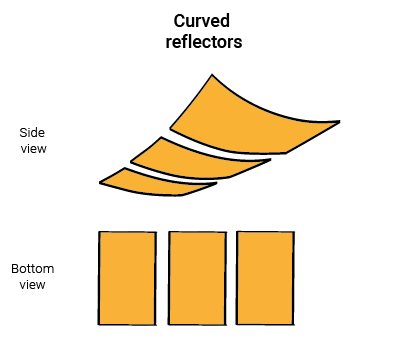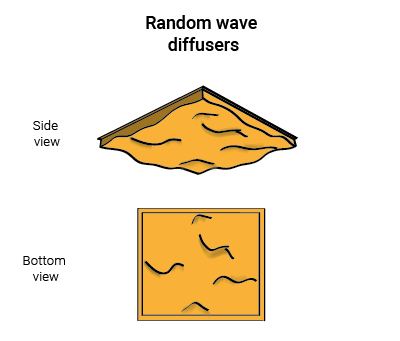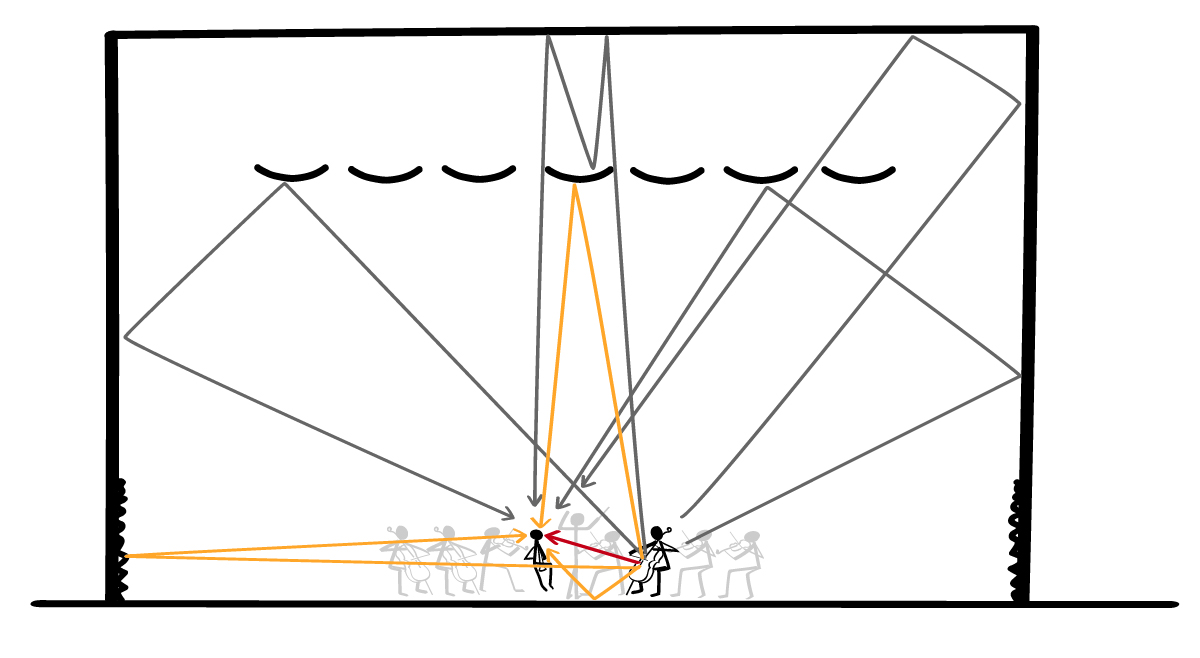
Part 1 was explaining what makes a successful acoustic design for music rehearsal rooms.
Part 2 here dives deeper into acoustic design by giving you a few tips for the planning of such spaces. It covers the following topics:
- Sound reverberation conditions
- Volume and space
- Room proportions and geometry
- Acoustic treatment
- Overhead reflectors
- Background noise levels
- Other general design considerations
At the end of this part, you will also find all the documents and the materials reviewed to help writing the articles.
Part 3, written by Ducks Sceno (Theatre Consultants) with contributions from Atelier Crescendo, highlights other general design considerations you should think about for rehearsal rooms.
Enjoy the read!
(See at the end the references used to confirm the concepts)

Do you want to be notified when new posts are published?
Why don’t you subscribe to Atelier Crescendo’s newsletter by clicking here?
Sound reverberation conditions for music rehearsal rooms
Good sound reverberation conditions in a large music rehearsal rooms contribute to:
- the audibility and the clarity of the musical messages
- the musical intonations
- the musical tones
- the articulations
- the balance of the sounds
Therefore, unsurprisingly, getting the reverberation conditions right is THE focus point for the acoustic design.
You need to consider:
- the overall sound reverberation quality of the rehearsal room to control the loudness and the clarity of the music played. You usually do this by adjusting the volume and the general amount of sound absorptive/reflective materials.
Note
read Sound reverberation – Part 1: Basics if you need a refresher about sound reverberation and reverberation time.
- the timing of the sound reflected back to the musicians (Do you remember? Part 1: The goals for a successful acoustic design explains the necessity to balance early and late reflected sound for musicians on stage). You manage this by adjusting the orientation and/or the shapes of the surfaces around the musicians and the orchestra conductor. Sometimes, you also need to add surfaces such as overhead reflectors, orchestra shells, etc.
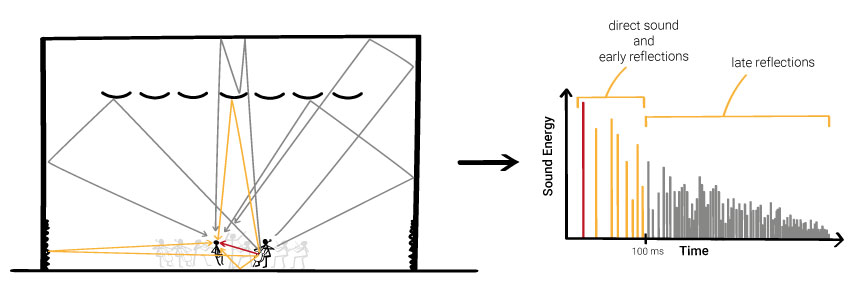
- the frequency content of the sound reflected back to the musicians (Do you remember? the end of Part 1: The goals for a successful acoustic design explains that musicians like to hear rythms and musical expressions that are mostly emitted at medium and high frequencies). Therefore, the reflected sound should contain less energy at low frequencies than at higher frequencies. You manage this by adjusting the dimensions and physical properties of the finishes and the materials (ex: thickness, width, length, density or also stiffness) around the musicians, so that they absorb more energy at low frequencies.
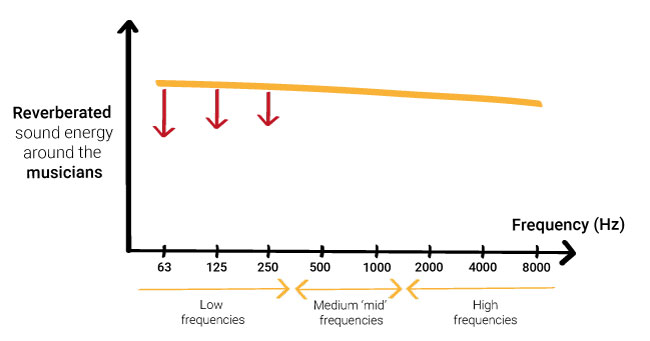
Volume and space for music rehearsal rooms
Part 1: The goals for a successful acoustic design explains that containing the sound energy of the music is key to ensure a successful rehearsal room.
For large ensembles (including 20 musicians), the room volume should to be relatively large so that the music doesn’t sound too loud. If the ensembles include loud instruments (such as brass instruments or also percussions), the volume should be even larger.
You shoud also set an area where artists will sit (or stand!) and make sure they are not too close to (vertical and flat) acoustically reflective surfaces like the walls.
Norwegian Standard 8178:2014 – Acoustic criteria for rooms and spaces for music rehearsal and performance provides guidance on the necessary volume and space for music rehearsal and perforance spaces depending on the type of music played inside. Read Acoustic design planning for music spaces for more details.
Note
The international standard ISO 23591:2021 – Acoustic quality criteria for music rehearsal rooms and spaces provides the same guidance.
For large music ensemble rooms with more than 20-25 musicians (our case here), you should consider the dimensions below.
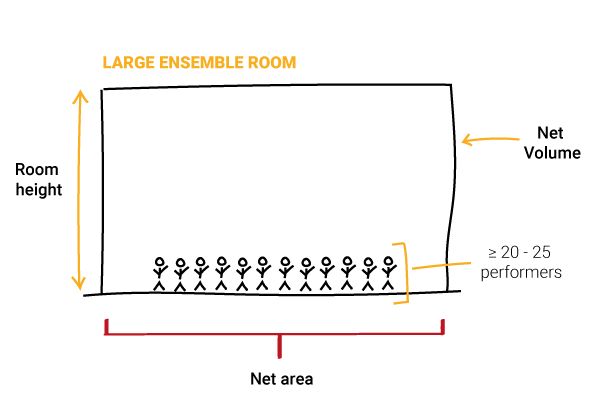
QUIET MUSIC
(just string instruments, choirs, etc)
Net volume
minimum 700 m3
Net floor area
minimum 50 m2
+
minimum 2 m2 /musician
Soffit / Ceiling height
minimum 5 m
LOUD MUSIC
(i.e. brass bands, concert bands, big bands,
percussion ensembles, symphony orchestras-
Net volume
minimum 30 m3 / musician
concert bands: minimum 1000 m3
brass bands: minimum 1500 m3
Symphony orchestras: minimum 1800 m3
Net floor area
minimum 120 m2
+
minimum 2 m2 /musician
Soffit / Ceiling height
minimum 5 m
Room proportions and geometry for music rehearsal rooms
One of the most successful shapes for large music ensemble rooms is the cuboïd shape such as a cube or the so called ‘shoebox’ shape.
What is a room with a shoebox shape? It is a room with a rectangular floor area, parallel side walls and tall ceiling / soffit. The base volume is two cubes located next to one another.
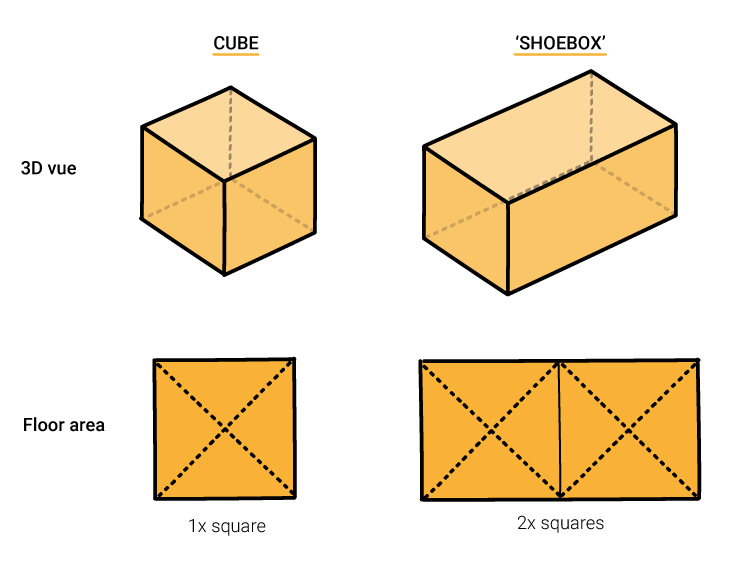
However, sound diffusive finishes and/or shapes should be planned to avoid creating flutter echoes.
You should also avoid any shapes that focus the sound in certain areas. This is because the sound field should be as ‘diffuse’ as possible in the room.
Note
you obtain a diffuse sound field in a space when the sound pressure level is uniform throughout the space.
Examples of shapes that focus sound are presented below.
avoid

Concave shapes
Dome

Curved wall
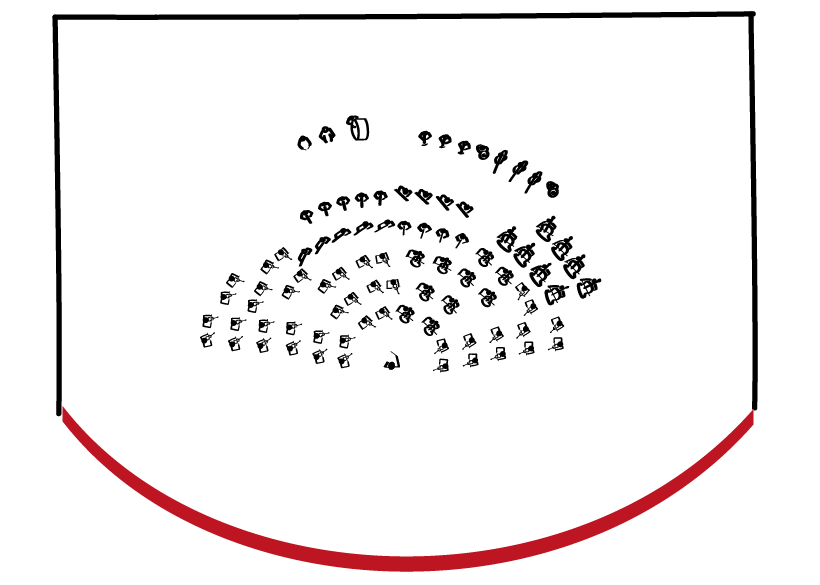
Avoid

pitched/slanted Shapes
Pitched ceiling
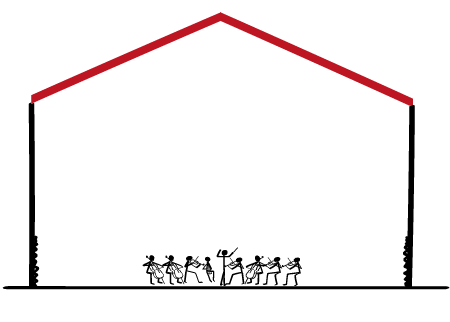
Angled walls
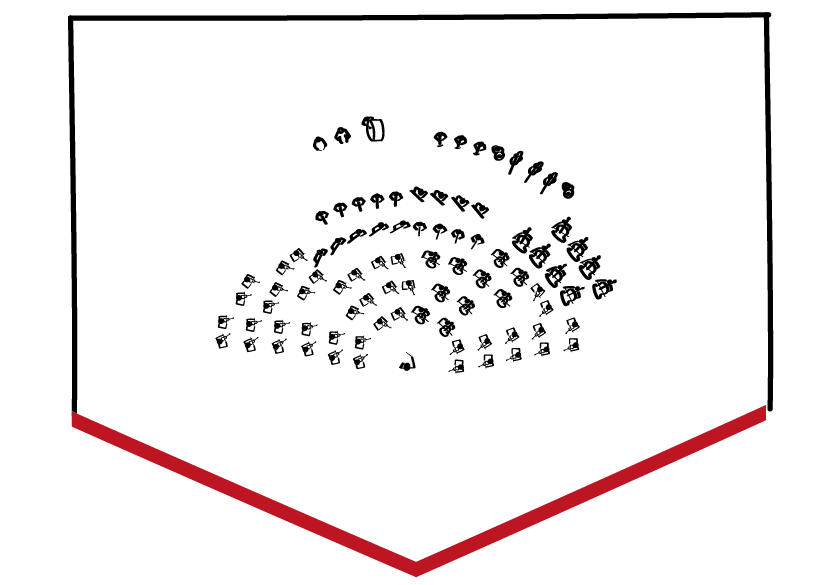
Acoustic treatment for music rehearsal rooms
For large music rehearsal rooms, it is very likely that most walls need to include some acoustic treatment (or at least acoustic consideration) in the form of sound absorption or sound diffusion.
The function of the acoustic treatment varies depending on:
- the location of the walls in relation to the orchestra
- the height of the wall section considered.
Therefore, this section presents acoustic design tips for :
- the wall behind the conductor
- the walls at low level
- the walls at upper level
Acoustic treatment for the walls of music rehearsal rooms
Wall behind the orchestra conductor
The wall behind the orchestra conductor should include some amount of sound absorption and/or diffusion.
This avoids strong ‘specular’ reflections to hit the wall and reach the conductor again, creating the perception of a virtual orchestra behind her/him (see below, specular and diffusive reflections are explained).
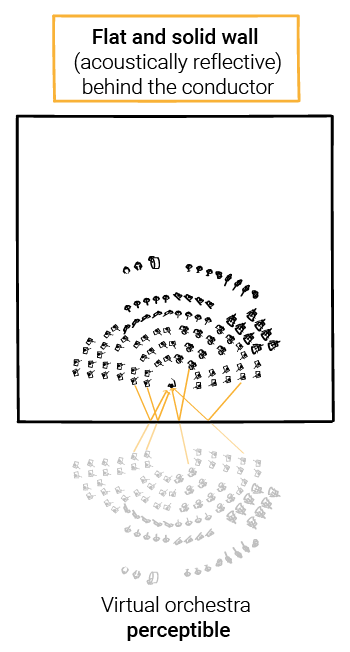

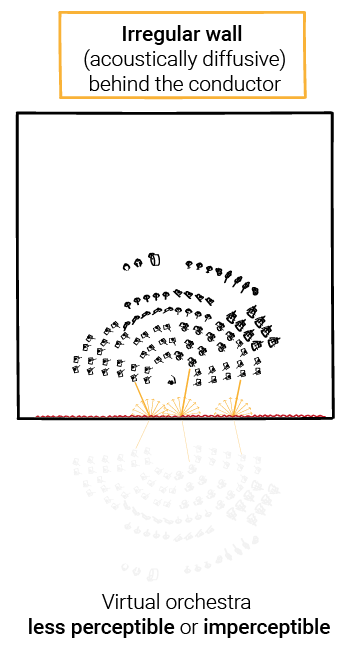
Note
what is a specular reflection? a specular reflection is, similarly to light reflected on a mirror, a reflection that bounces off a surface with the same angle as when it hits the surface. A diffusive reflection is a reflection that bounces off a surface in different directions.

Walls at low level
Assuming most musicians face the conductor, you should avoid sound absorbing finishes at low level, i.e. approximately below head height. Instead, you should favor elements that reflect and diffuse sound at medium and high frequencies.
This ensures that the conductor and the orchestra receive lateral sound reflections (musicians rely more on lateral reflections to hear themselves and others).
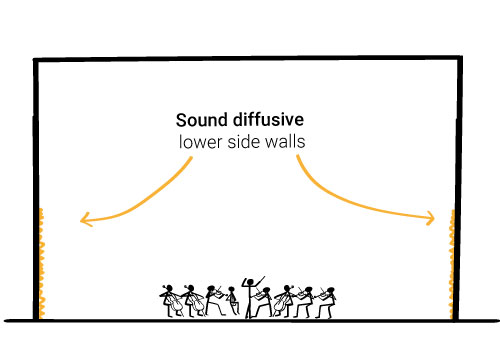
However, there could be an option for these surfaces to absorb some amount of acoustic energy at low frequencies.
For this applications, materials that can absorb sound at low frequencies generally include:
- a sheet / board /face that is not so dense
- a cavity behind with sound absorption inside as an option.
Examples of such materials are:
- plasterboard or gypsum based boards on frame
- timber sheets/boards mounted on frame
- suspended ceilings
Note
There are many other specialist materials and configurations that can absorb sound at low frequencies.
On the walls located far from the musicians, it might be necessary to install sound absorbing finishes to avoid any late (or unwanted) reflected sound.
Walls at upper level
The upper walls, i.e. approximately above head height, can include sound diffusive surfaces.
However, they are a good location to add broadband absorption materials to lower the overall sound reverberation within the rehearsal room.

Note
What are broadband absorption materials? they are materials that absorb sound over a large range of frequencies. Examples of such materials are fibre, wool or also foam based materials.
Acoustic treatment for the ceiling / soffit of music rehearsal rooms
A fully or partially sound absorptive ceiling can also be useful to reduce the overall sound reverberation within the rehearsal room. Especially when you need to absorb sound at low frequencies.
Acoustic consideration for the floor of music rehearsal rooms
Hard floor finish fixed on concrete hardly absorbs any sound.
However, a raised hard floor finish can absorb sound at some low frequencies due to the cavity created by the system.
This feature can be particularly useful for the musicians who rely on reflected sound at medium and high frequencies (as mentionned previously).
For the same reason, carpet should be avoided as it absorbs sound at medium and high frequencies.
See below some ideas of sound absorption performances achieved by different floor finishes.
Sound absorption coefficients of different floor finishes
(ref: Acoustic Absorbers and Diffusers, Theory, Design and Application – Third Edition – Trevor J. Cox and Peter D’Antonio)
Overhead reflectors for music rehearsal rooms
For large and tall spaces where large orchestras play, it might be necessary to plan for sound reflectors above the musicians, also called ‘overhead reflectors’.
They are useful to provide additional early reflections and improve the acoustic conditions within the orchestra. Sometimes, additional wall reflectors above head height or even orchestra shells are also installed to provide the same effect.
For large (and loud) ensembles, overhear reflectors should be at approximately 8-10 m above the floor level.
For small (and quiet) ensembles, they could be located as low as 6 m above the floor level .
Note
If the overhead reflectors are too low, they could cause some loudness issues (i.e. the music will sound too loud)
You should favor arrays of smaller reflectors, instead of a single large reflector or just a few large reflectors, to optimise the diffusion of the acoustic energy across the orchestra.
Some of the most common shapes for overhead reflectors are curved (convex), random waves, ‘QRD’ type (‘QRD’ stands for Quadratic Residue Diffuser) or any other shapes with irregular and random width and depth.
Flat reflectors should also be avoided.
See below some examples of acoustic diffusers (although many other types of diffusers exist).
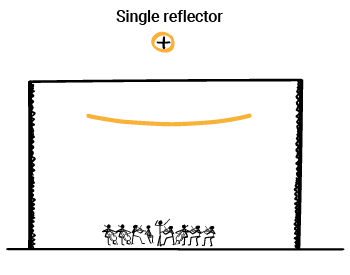

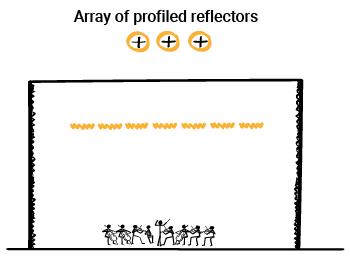
You should favour relatively dense and stiff materials to ensure that sound hitting the reflector is not absorbed, especially at the lower frequencies due to the resonance of the reflectors (you can read Solid free hanging panels can absorb sound if you want to know how this is possible).
Examples of materials are:
- gypsum based
- dense plaster
- wood particle or fibre based
- glass
Did you know?
Even with a dense and stiff material, a flat reflector can resonate and absorb sound at low frequencies. Curving it will stiffen it, increase its natural frequency and reduce the low frequency absorption.
Background noise levels in music rehearsal rooms
A music rehearsal room is an environment where the musicians need to hear their own musical details and those of the other musicians.
Because a high background noise can mask these details, it is important to keep it as low as possible when the space is in use.
Sometimes, music rehearsal rooms are also used as large recording studios for large ensembles and orchestras. So it is important to ensure acoustic conditions suitable for recording activites, i.e. with a very low background noise levels.
Therefore, the acoustic design should include control of noise from (some of or all) the following sources:
- ventilation systems
- mechanical systems and machineries
- electrical systems
- external noise (such as road, air or even rail traffic)
References for acoustic design of music rehearsal rooms
The following documents and materials have been reviewed to write this article and Part 1: The goals for a successful acoustic design .
J. Meyer – Some problems of opera house acoustics – Proceedings – Symposium on acoustics and theatre planning for the performing arts (1986)
P. Adams – Acoustic design of large rehearsal spaces – Proceedings – ISRA (2019)
A. Gade – Investigation of musicians’ room acoustic conditions in concert halls, Part I: Field experiments and synthesis of results – Acustica (1989)
A. Gade – Investigation of musicians’ room acoustic conditions in concert halls, Part II: Methods and laboratory experiments – Act Acustica United & Acustica (1989)
International Standard Organisation – “ISO 3382-1 – acoustics measurement of room acoustic parameters – Part 1: Performance spaces” (2009)
R. Wenmaekers – How orchestra members influence stage acoustic parameters on five different concert hall stages and orchestra pits – Journal of the Acoustical Society of America ‘JASA’ (2016)
J Dammerud – Attenuation of direct sound and the contributions of early reflections within symphony orchestras – ournal of the Acoustical Society of America ‘JASA’ (2010)
L. Panton – Investigating auditorium acoustics from the perspective of musicians – PhD thesis – University of Tasmania (2017)
European Parliament and Council, Directive 2003/10/EC on the minimum health and safety requirements regarding the exposure of workers to the risks arasing from physical agents (noise) (2003)
Sound Advice: Control of noise at Work in music and entertainment – the Health and Safety Executive (2008)
E. Hatlevik – Are musicians affected by room acoustics in rehearsal rooms – Master’s Thesis – Norwegian University of Science and Technology NTNU (2012)
O. Riduan – Designing small music practice rooms for sound quality – Proceedings – International Congress on Acoustics (2010)
C. Pop – Music practice rooms: Ambitions, limitations and practical acoustic design – Proceedings – International Symposium on Music Acoustics (2019)
H. Drotleff – New room acoustic design concept for rehearsal rooms – CFA DAGA ’04 , Strasbourg 22-25/03/2004 (2004)
H. Koskinen – Facilities for music education and their acoustical design – article – International Journal of Occupational Safety and Ergonomics
McCue – Rehearsal room Acoustics, acoustical design of music education facilities – Journal of Acoustical Society of America (1990)
Lamberty – Music Practice Rooms – Journal of Sound and Vibration (Vol. 60, No.1)
R. Walker – Acoustic Criteria and Specification – BB R&D White paper WHP021 (2002)
Skalevik – Rehearsal room acoustics for the orchestra musician – Proceedings – Baltic-Nordic Acoustics Meeting (2014)
O’Brien et al. – Nature of orchestral noise – Journal of Acoustic Society of America (2008)
G. Leitermann – Theatre Planning – A focal press book (2017)
J. Strong – Theatre Buildings – A design guide – Association of british theatre technicians (2010)
Norwegian Standard NS 8178:2014 – Acoustic criteria for rooms and spaces for music rehearsal and performance
R. Wenmaekers – Stage acoustics sound exposure – www.stageacoustics.wordpress.com/sound-exposure-reduction

